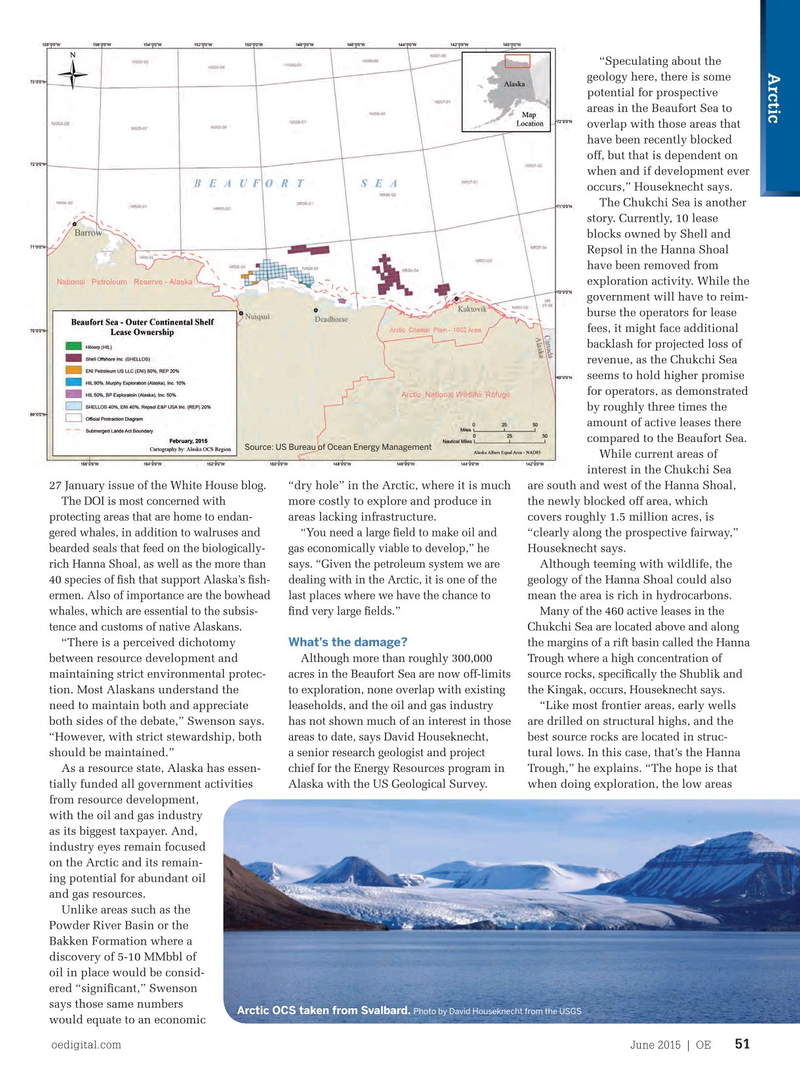
Page 49: of Offshore Engineer Magazine (Jun/Jul 2015)
Read this page in Pdf, Flash or Html5 edition of Jun/Jul 2015 Offshore Engineer Magazine
“Speculating about the
Arctic geology here, there is some potential for prospective areas in the Beaufort Sea to overlap with those areas that have been recently blocked off, but that is dependent on when and if development ever occurs,” Houseknecht says.
The Chukchi Sea is another story. Currently, 10 lease blocks owned by Shell and
Repsol in the Hanna Shoal have been removed from exploration activity. While the government will have to reim- burse the operators for lease fees, it might face additional backlash for projected loss of revenue, as the Chukchi Sea seems to hold higher promise for operators, as demonstrated by roughly three times the amount of active leases there compared to the Beaufort Sea.
Source: US Bureau of Ocean Energy Management
While current areas of interest in the Chukchi Sea 27 January issue of the White House blog. “dry hole” in the Arctic, where it is much are south and west of the Hanna Shoal,
The DOI is most concerned with more costly to explore and produce in the newly blocked off area, which protecting areas that are home to endan- areas lacking infrastructure. covers roughly 1.5 million acres, is gered whales, in addition to walruses and “You need a large feld to make oil and “clearly along the prospective fairway,” bearded seals that feed on the biologically- gas economically viable to develop,” he
Houseknecht says. rich Hanna Shoal, as well as the more than says. “Given the petroleum system we are
Although teeming with wildlife, the 40 species of fsh that support Alaska’s fsh- dealing with in the Arctic, it is one of the geology of the Hanna Shoal could also ermen. Also of importance are the bowhead last places where we have the chance to mean the area is rich in hydrocarbons.
Many of the 460 active leases in the whales, which are essential to the subsis- fnd very large felds.”
Chukchi Sea are located above and along tence and customs of native Alaskans. “There is a perceived dichotomy What’s the damage?
the margins of a rift basin called the Hanna
Although more than roughly 300,000 Trough where a high concentration of between resource development and acres in the Beaufort Sea are now off-limits source rocks, specifcally the Shublik and maintaining strict environmental protec- to exploration, none overlap with existing the Kingak, occurs, Houseknecht says. tion. Most Alaskans understand the leaseholds, and the oil and gas industry need to maintain both and appreciate “Like most frontier areas, early wells has not shown much of an interest in those both sides of the debate,” Swenson says. are drilled on structural highs, and the areas to date, says David Houseknecht, “However, with strict stewardship, both best source rocks are located in struc- a senior research geologist and project should be maintained.” tural lows. In this case, that’s the Hanna chief for the Energy Resources program in
As a resource state, Alaska has essen- Trough,” he explains. “The hope is that
Alaska with the US Geological Survey. tially funded all government activities when doing exploration, the low areas from resource development, with the oil and gas industry as its biggest taxpayer. And, industry eyes remain focused on the Arctic and its remain- ing potential for abundant oil and gas resources.
Unlike areas such as the
Powder River Basin or the
Bakken Formation where a discovery of 5-10 MMbbl of oil in place would be consid- ered “signifcant,” Swenson says those same numbers
Arctic OCS taken from Svalbard. Photo by David Houseknecht from the USGS would equate to an economic oedigital.com June 2015 | OE 51 050_OE0615_Geo1_Heather.indd 51 5/31/15 9:22 PM

 48
48

 50
50